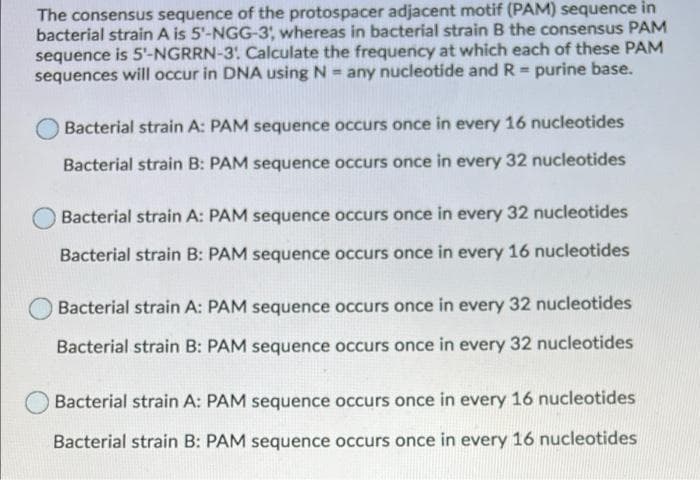The consensus sequence of the protospacer adjacent motif (PAM) sequence in bacterial strain A is 5'-NGG-3, whereas in bacterial strain B the consensus PAM sequence is 5'-NGRRN-3. Calculate the frequency at which each of these PAM sequences will occur in DNA using N- any nucleotide and R purine base. Bacterial strain A: PAM sequence occurs once in every 16 nucleotides Bacterial strain B: PAM sequence occurs once in every 32 nucleotides Bacterial strain A: PAM sequence occurs once in every 32 nucleotides Bacterial strain B: PAM sequence occurs once in every 16 nucleotides Bacterial strain A: PAM sequence occurs once in every 32 nucleotides Bacterial strain B: PAM sequence occurs once in every 32 nucleotides Bacterial strain A: PAM sequence occurs once in every 16 nucleotides Bacterial strain B: PAM sequence occurs once in every 16 nucleotides
The consensus sequence of the protospacer adjacent motif (PAM) sequence in bacterial strain A is 5'-NGG-3, whereas in bacterial strain B the consensus PAM sequence is 5'-NGRRN-3. Calculate the frequency at which each of these PAM sequences will occur in DNA using N- any nucleotide and R purine base. Bacterial strain A: PAM sequence occurs once in every 16 nucleotides Bacterial strain B: PAM sequence occurs once in every 32 nucleotides Bacterial strain A: PAM sequence occurs once in every 32 nucleotides Bacterial strain B: PAM sequence occurs once in every 16 nucleotides Bacterial strain A: PAM sequence occurs once in every 32 nucleotides Bacterial strain B: PAM sequence occurs once in every 32 nucleotides Bacterial strain A: PAM sequence occurs once in every 16 nucleotides Bacterial strain B: PAM sequence occurs once in every 16 nucleotides
Biology: The Dynamic Science (MindTap Course List)
4th Edition
ISBN:9781305389892
Author:Peter J. Russell, Paul E. Hertz, Beverly McMillan
Publisher:Peter J. Russell, Paul E. Hertz, Beverly McMillan
Chapter19: Genomes And Proteomes
Section: Chapter Questions
Problem 1ITD: Below is a sequence of 540 bases from a genome. What information would you use to find the...
Related questions
Question

Transcribed Image Text:The consensus sequence of the protospacer adjacent motif (PAM) sequence in
bacterial strain A is 5'-NGG-3, whereas in bacterial strain B the consensus PAM
sequence is 5'-NGRRN-3: Calculate the frequency at which each of these PAM
sequences will occur in DNA using N = any nucleotide and R = purine base.
Bacterial strain A: PAM sequence occurs once in every 16 nucleotides
Bacterial strain B: PAM sequence occurs once in every 32 nucleotides
Bacterial strain A: PAM sequence occurs once in every 32 nucleotides
Bacterial strain B: PAM sequence occurs once in every 16 nucleotides
Bacterial strain A: PAM sequence occurs once in every 32 nucleotides
Bacterial strain B: PAM sequence occurs once in every 32 nucleotides
Bacterial strain A: PAM sequence occurs once in every 16 nucleotides
Bacterial strain B: PAM sequence occurs once in every 16 nucleotides
Expert Solution
This question has been solved!
Explore an expertly crafted, step-by-step solution for a thorough understanding of key concepts.
This is a popular solution!
Trending now
This is a popular solution!
Step by step
Solved in 2 steps

Knowledge Booster
Learn more about
Need a deep-dive on the concept behind this application? Look no further. Learn more about this topic, biology and related others by exploring similar questions and additional content below.Recommended textbooks for you

Biology: The Dynamic Science (MindTap Course List)
Biology
ISBN:
9781305389892
Author:
Peter J. Russell, Paul E. Hertz, Beverly McMillan
Publisher:
Cengage Learning

Biology: The Dynamic Science (MindTap Course List)
Biology
ISBN:
9781305389892
Author:
Peter J. Russell, Paul E. Hertz, Beverly McMillan
Publisher:
Cengage Learning